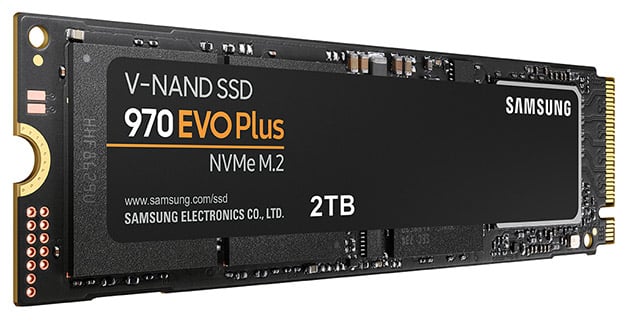Samsung SSD 970 EVO Plus Review: Optimized For Speed
We’ve got a table below comparing the 970 EVO Plus series specifications to the original EVOs. As you can see, there are only a few areas that differ. Write performance and IOPS are improved, but capacities and endurance remain similar. The differences between the two drive families lie in the newer NAND and firmware tweaks incorporated into the SSD 970 EVO Plus.
|

As with the original Samsung SSD 970 EVOs, the new SSD 970 EVO Plus series will be offered in four capacities, ranging from 250GB all the way on up to a beefy 2TB, though the 2TB model won’t be arriving until later in Q1 (April). We’ve got 250GB and 1TB drives on hand for testing here.
All of the drives in both the Samsung SSD 970 EVO Plus series have the same M.2 (2280) "gumstick" form factor and offer peak read bandwidth of up to 3.5GB/s. Write bandwidth tops out at 3.3GB/s, which is a healthy uptick from the 970 EVOs 2.5GB/s. The drives’ max IOPS ratings vary depending on queue depth, but peak at right around 620K for reads (at QD32) and 560K for writes. The drives’ endurance ratings also vary based on capacity, and peak at 1200TBW 2TB 970 EVO Plus. Endurance drops as capacities decrease, as you would expect, but they remain in-line with the original 970 EVO drives.
All of the drives in the 970 EVO Pus series feature Samsung’s latest 3-bit per cell 96-layer TLC V-NAND and the Phoenix controller that appeared with the original 970 EVOs and Pro. The Phoenix controller has a native PCIe gen 3 interface and supports the NVMe 1.3 protocol. Other details are scarce on the controller, but Samsung claims it enables enhanced performance and has improved thermal characteristics over previous gen offerings, thanks to a new nickel coating on the controller itself that helps to better dissipate heat. A new DTG (Dynamic Thermal Guard) algorithm incorporated into the firmware also helps the 970 EVO Plus better manage long, sequential transfers than the 970 EVO, before throttling due to thermal saturation. Samsung claims the EVO Plus is up to 53% better than the EVO at handling, long, sustained workloads.
Back to the Phoenix controller for a bit. One of the controller’s cores is dedicated to optimizing communications between it and the host system, and the controller is clocked higher than the one on previous-gen drives as well, to boost peak transfer speeds and reduce latency. The Phoenix controller supports all of the features you’d expect from a current SSD, like TRIM, garbage collection, S.M.A.R.T., etc., and it supports various encryption technologies as well. Depending on the capacity, all of the drives also feature 512MB to 2GB of discrete LPDDR4 DRAM cache.

The TurboWrite buffer size dynamically adjusts based on the workload. With the 500GB model, for example, if the user's dataset is under 4GB, TurboWrite uses the pre-allocated (default) TurboWrite region. If it is more than 4GB, however, the 970 EVO can use an additional 18GB dynamic SLC buffer for a total of 22GB SLC buffer. Obviously, on the higher capacity drives, the buffer can be larger. The default and dynamic sizes of the buffers are defined in the chart above.

TurboWrite should allow the SSD 970 EVO Plus series to perform well in the vast majority of consumer-class, short, bursty workloads. As you can see in the screen-capture above (taken from HD Tune using a 250GB drive), writes are much faster when the TurboWrite buffer is being utilized, but once it is exhausted, write performance tapers, becomes more erratic, and eventually drops off to a lower rate.

Samsung warranties the SSD 970 EVO Plus series drives for 5 years, which is very good for a consumer-class SSD. All told, the new Samsung SSD 970 EVO Plus series is essentially an evolution of the existing EVOs, that leverages new NAND technology, and should offer better overall performance in a similar package.
Let’s put them to the test and find out...









